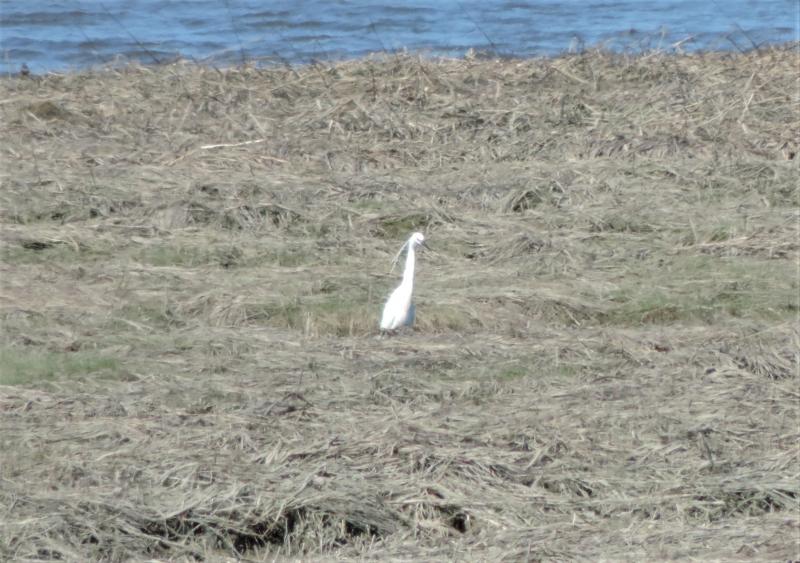The Longest Lasting Rare Maine Bird
A few days ago a little egret was found at Maine Audubon’s Gilsland Farm in Falmouth. A few years ago such news would have resulted in crowds of birders descending on the site. That is what happened in 2011 when the first one was found in Maine at Scarborough Marsh. That’s because a “little egret” is not just a small, white heron of any kind (like the familiar snowy egret); it is a very particular species of egret that until the 1950s was known only as an inhabitant of Europe, Asia, and Australia. In 1954 single individual little egrets were discovered in both Newfoundland and Barbados. Many years later, in 1980, one was found in Quebec, and two or three in were seen Nova Scotia in 1989. The first record in the U.S. was also in 1989, at nearby Plum Island, Massachusetts. But it took another 22 years for one to be identified in Maine.
Little egrets are best differentiated from the very similar snowy egret by their two long head plumes (snowy egrets just have a fuzzy hairdo with no long head plumes). The first time a little egret was found at Gilsland Farm was in summer 2015, and one has been there and nearby every summer since then. It seems likely that the same individual has been returning, which would make this the fifth year it has been coming back.
Five years of the same rare bird returning to the same spot is pretty impressive. But Maine has had a few other rare birds with long tenures at or near the same location.
One that we remember well was the western grebe that appeared off Indian Point in Georgetown. That bird was first found in December of 1977, becoming Maine’s first record of this species, which normally winters only along the Pacific Coast. Incredibly, the bird continued wintering there for at least 16 years! We had the good fortune to see it a number of times there through the 1980s, and our western grebe adventures include one memorable trip when we nearly got our car permanently stuck in the mud during a late-winter thaw. We managed to dig out our little Chevette but not without it—and ourselves!—covered in mud!
While the western grebe still holds the record for the longest rare bird tenure in Maine, the red-billed tropicbird that has been coming back to Seal Island National Wildlife Refuge and Matinicus Rock since 2005 seems likely to become the new front runner. It only needs one more year to tie and two to win!
Although less rare, a lesser black-backed gull first discovered in 2006 or 2007 on Appledore Island came back for seven summers, parenting a number of hybrid offspring with his herring gull female mates over the years. That bird was banded and became quite well known by Florida birders as he spent winters on Daytona Beach.
Sometimes there are places that have rare or unusual birds of a particular species every year, but we know that it is likely that the “founding fathers and mothers” in such instances have been replaced by their offspring. There is a site along the Merriland River in Wells that was one of the early places where Louisiana waterthrushes were first found nesting in the state back in the 1980s. Since about 1983, we used to visit the site—a gorgeous shady, hemlock-lined bubbly brook—every year in May and June to see the birds. We and others still find Louisiana waterthrushes there to this day—closing in on four decades later! Small songbirds like waterthrushes and other warblers (yes, waterthrushes are warblers despite the different sounding name) typically live fairly short lives. If they make it through the first perilous year when about two-thirds of them succumb, the adults may survive to 5-8 years, if they are lucky. So it is pretty clear that the Louisiana waterthrushes that we have been seeing every year on the Merriland River are a series of offspring of successive generations. This means that generations of waterthrushes have been successfully raising young there. That’s a very hopeful kind of long-term bird tenure. Kind of makes us think of old family homesteads passed down through the generations…
Jeffrey V. Wells, Ph.D., is a Fellow of the Cornell Lab of Ornithology. Dr. Wells is one of the nation's leading bird experts and conservation biologists and author of “Birder’s Conservation Handbook”. His grandfather, the late John Chase, was a columnist for the Boothbay Register for many years. Allison Childs Wells, formerly of the Cornell Lab of Ornithology, is a senior director at the Natural Resources Council of Maine, a nonprofit membership organization working statewide to protect the nature of Maine. Both are widely published natural history writers and are the authors of the book, “Maine’s Favorite Birds” and “Birds of Aruba, Bonaire, and Curaçao: A Site and Field Guide” from Cornell Press.





























